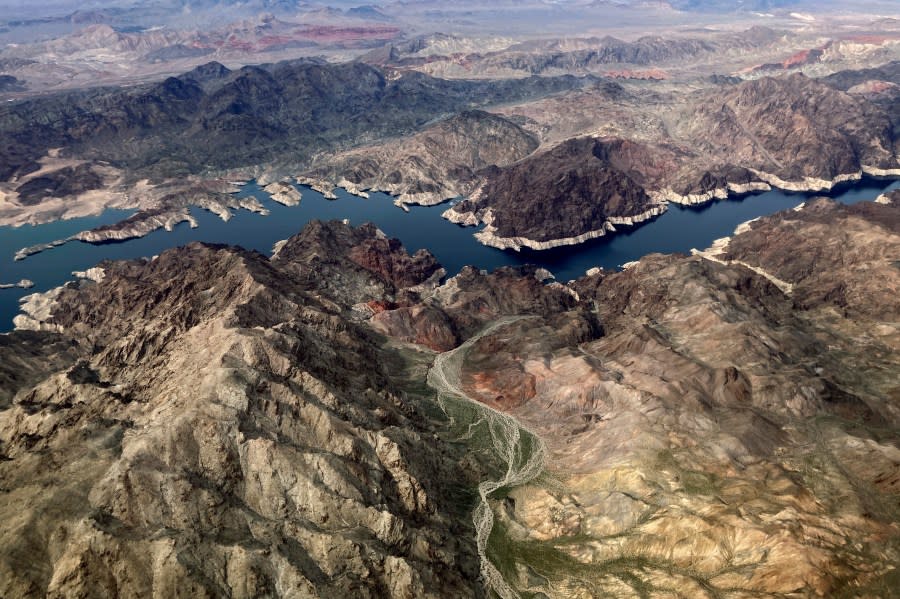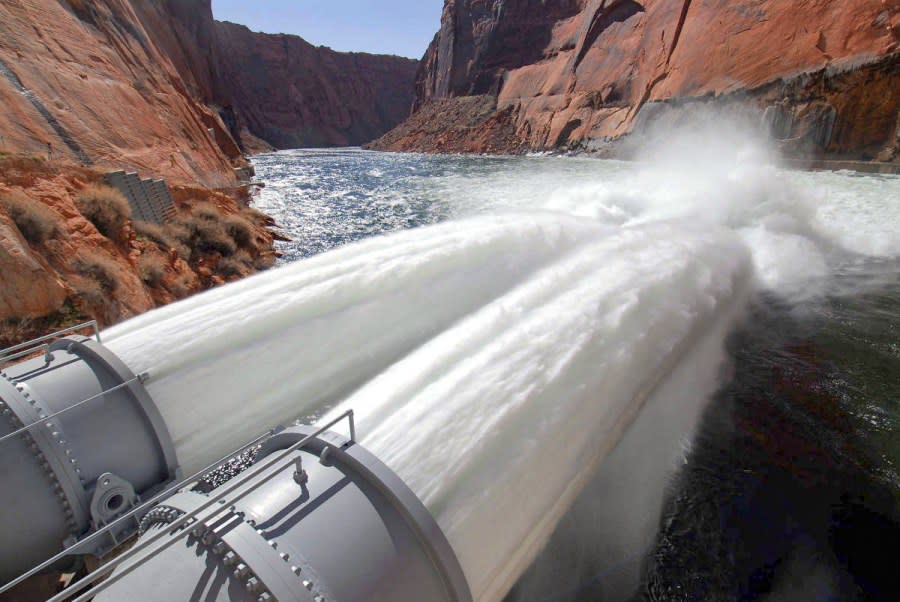Plan for Colorado River conservation released to get through 2026
LAS VEGAS (KLAS) — Plans to conserve Colorado River water are central to a two-year course of action laid out by the federal government on Tuesday.
A final Supplemental Environmental Impact Statement (SEIS) released by the U.S. Bureau of Reclamation sets the parameters for getting through the drought — but just through 2026. The plan offers several alternatives, and the final decision on which course to follow will come later this year — an election year, which could weigh on the timetable.
The SEIS is banking — literally, water banking — on conserving 3 million acre-feet of river water over a three-year period through agreements to use less water and store the extra in Lake Mead and Lake Powell to avoid emergencies like the ones that cropped up in 2022.
The Biden administration news release announcing the SEIS and three new water conservation agreements in California celebrates the water win before it has even happened. In fact, an Interior Department official said in October that the desert Southwest would be on stable footing “for the next few years.” Now, the chance of lake levels falling below critical elevations has been reduced to 8% at Lake Powell and 4% at Lake Mead through 2026, officials said.
Whether that’s due to last year’s wet winter or the government’s confidence in conservation measures, the government still has to go through the motions of making a decision. And that’s what the SEIS process is all about. States must sign off on the decision when it comes.
The government also noted today’s water level at Lake Mead, but actually shortchanged the progress by more than a foot and a half — the equivalent of about 36 billion gallons of water. The lake’s surface on Tuesday was at 1,076.60 feet above sea level. The lake has been rising since Dec. 1, but it’s expected to begin a steep drop in March.

Reclamation Commissioner Camille Calimlim Touton thanked everyone involved in assembling the plan “for their unprecedented level of collaboration throughout this process” in a Tuesday statement.
“As we move forward, supported by historic investments from the President’s Investing in America agenda, we will continue working collaboratively to ensure we have long-term tools and strategies in place to help guide the next era of the Colorado River Basin,” the statement said.
The “preferred alternative” allows for reducing releases from Lake Powell — usually 7 million acre-feet or more — down to 6 million acre-feet if the reservoir is projected to go below 3,500 feet (surface elevation) in year-ahead forecasts. An acre-foot is enough water to supply two to three households for an entire year.
In many ways, the SEIS’s preferred alternative mirrors the approach of the Southern Nevada Water Authority’s (SNWA) plan, which was released in May of 2023 during a time when negotiations between states appeared to have broken down.
The short-term solution relies on conservation and commitments made by Nevada, Arizona and California — mostly by water agencies and farming districts. A table in the SEIS spells out what is expected:

The solution is on the backs of Lower Colorado River Basin states in the desert Southwest. Conservation in Nevada, Arizona and California is the core of the short-term plan. Conservation programs in the Upper Basin tend to be voluntary with financial incentives.
“The states’ preferred alternative makes the Upper Basin happy by protecting Lake Powell’s elevations and imposing no cuts on those states. The proposal provides a clear set of cuts and emergency management criteria to the Lower Basin,” Kyle Roerink, executive director of the conservation-minded Great Basin Water Network, said Tuesday.
“But what’s more important is what this document doesn’t explicitly say: With our below-average snowpack, we are quickly eating into our savings from last year’s big winter and recent federal projections show that we are headed back to the brink of a crash in a few years,” he said.
For Nevada, the commitment of saving as much as 75,000 acre-feet in 2024 and dropping after that falls below current water usage.
Reclamation figures show that Nevada used 186,621 acre-feet of river water in 2023. Infrastructure that allows us to recycle water used indoors and return it to Lake Mead — and receive credit — keeps actual consumption low. But water used outdoors is lost. That’s why SNWA has been aggressive in its programs to get rid of residential lawns and other “ornamental” grass that uses a lot of water.
There are plenty of ideas that were thrown out in the process. Those included suggestions to:
Fill Lake Mead first
Decommission Glen Canyon Dam
fill Lake Powell first
The “preferred alternative” also doesn’t account for evaporation — a complaint argued by the Upper Basin states, which historically paid closer attention to water loss that Arizona and California, where old canal systems transport water to where it’s needed.
SNWA argued in its proposal for taking evaporation into account. Water lost in transit would have produced a 10% to 15% penalty for Arizona and California.
“We have no certainty looking past 2026, and that’s an unnerving prospect knowing what we know about the likelihood of dry hydrology coming down the pike,” Roerink said.

A joint statement from the Lower Colorado River Basin States (Arizona, California and Nevada) said:
The plan for additional near-term water use reductions released today provides the stability
we need to fully focus on long-term solutions to challenges ahead on the Colorado River. We
are grateful to our federal partners at the Bureau of Reclamation for recognizing that the
consensus approach proposed by the Lower Basin States last year for these near-term
operations is the best way to protect the Colorado River system through 2026.
That spirit of cooperation continues to guide us as we work to resolve the even greater
challenge ahead – planning the river’s long-term sustainability. As we negotiate the next set of
guidelines for Colorado River operations after 2026, the success of these water conservation
commitments reminds us that only by working together, each making sacrifices, will we see real
results.
In 2023, Arizona, California and Nevada already took a significant step toward fulfilling our
conservation commitment through 2026 made under the Lower Basin Plan – together
conserving more than 1.1 million acre-feet of water that has been left in Lake Mead, in addition
to more than 600,000 acre-feet contributed under previous commitments. Our use of Colorado
River water last year was the lowest since 1983. This accomplishment was achieved not
through litigation, but through collective recognition that the river’s health is the responsibility
of everyone who relies on it.
U.S. Rep. Dina Titus, D-Nev., is a founding member of the bipartisan Colorado River Caucus. She released the following statement on Tuesday:
“With the Colorado River Basin’s rapidly changing water levels, all Basin states face a pressing need to work together to establish a path forward for water users in the region. Thanks to investments from the Inflation Reduction Act, several local governments, Tribal Nations, and Native communities have already committed to record water conservation measures. This promoted all Colorado River Basin states to reach a historic, fair-share agreement through 2026 which the Bureau of Reclamation announced today it will soon implement. Nevada has led the nation on water conservation, and I look forward to working with my colleagues in the Congressional Colorado River Caucus to ensure our state’s allocation of this precious resource is protected in the long-term.”
For the latest news, weather, sports, and streaming video, head to KLAS.

